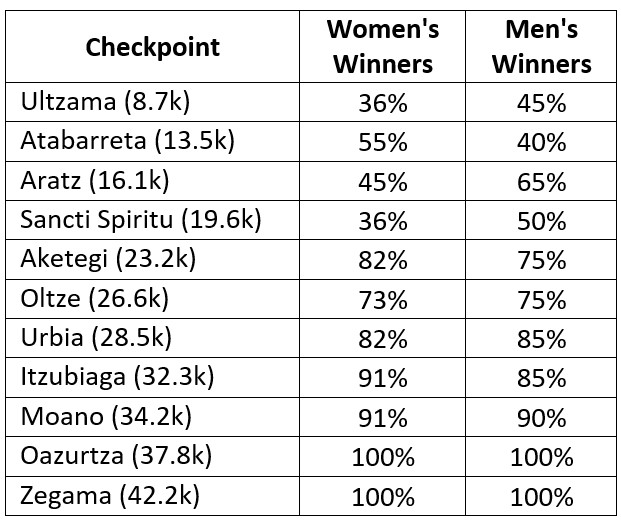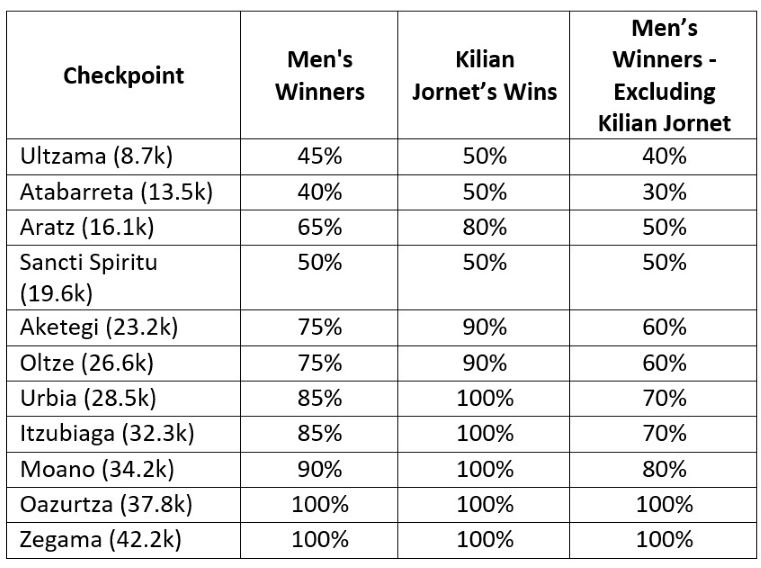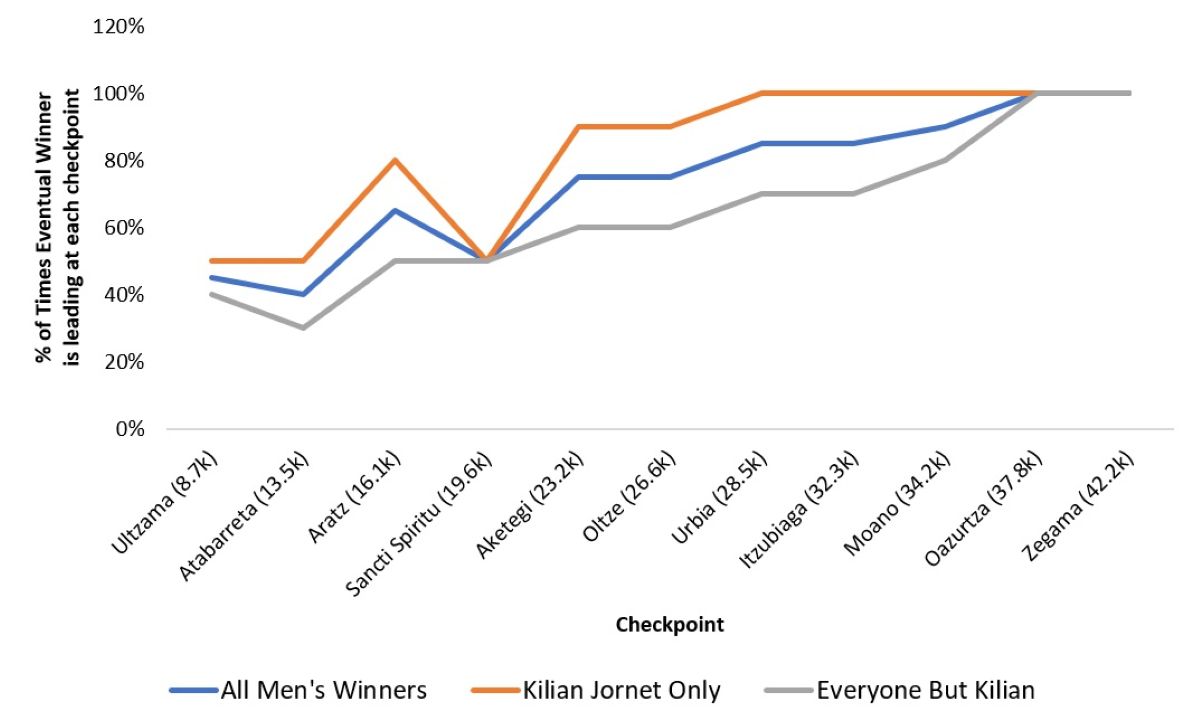Of the 2 winners of the 2024 Zegama-Aizkorri Marathon, one took the lead after 13 kilometers and pulled away from the remainder of the lead pack within the second half of the race, whereas the opposite was already main by the primary checkpoint. Was both race technique, from Norway’s Sylvia Nordskar and Spain’s Kilian Jornet, respectively, extra typical for this iconic occasion?
Established, aggressive races supply a particular alternative to review racing technique. A race that has over a decade’s value of aggressive ends in a deep subject lets us dig into whether or not prime runners have a tendency to guide from the beginning or run with a pack. We are able to have a look at whether or not they safe their lead on a specific climb, descent, or mileage marker. iRunFar revealed an identical evaluation in 2022 for UTMB. This time, due to a race group that generously shared years of race splits with us, we’re doing one thing comparable for this marathon-distance path race.

Sylvia Norkskar on her option to successful the 2024 Zegama Marathon: Photograph: Zegama Marathon/Igor Quijano
Concerning the Zegama Marathon
Held yearly in Could within the Basque Autonomous Area, this 42-kilometer path race entails over 2,700 meters (about 8,600 toes) of elevation on technical terrain. The course departs from the city of Zegama, climbs to the Otzaurte mountain, reaches its highest level at Aketegi, and returns to Zegama for the end. Runners have eight hours to cowl the space and, as of publication:
- Nienke Brinkman (The Netherlands) holds the ladies’s course document of 4:16:43, set in 2022, and
- Kilian Jornet holds the lads’s course document of three:36:40, additionally set in 2022.
Methodology
To find out how the highest of the sphere is dispersed at every checkpoint over time, I created a grasp spreadsheet from 11 years’ value of race splits, kindly supplied to me by the race administrators. As a result of Kilian Jornet has gained the race 11 occasions in its 20-year historical past, I additionally analyzed splits for the highest of the lads’s subject, going again to 2002. As a result of the format of the Excel paperwork diverse over time, I normalized the information to the most effective of my means, as somebody who hasn’t been on the Zegama course personally. The names and orders of the checkpoints point out there have been probably modest modifications to the route or a minimum of the timing factors from one 12 months to the following.
The best problem I confronted was that a number of years’ value of splits didn’t separate racers by gender. I due to this fact needed to establish the highest ladies’s finishers by cross-referencing the splits with different sources with the general race outcomes. There’s a probability I missed ladies who have been working on the entrance of the sphere early within the race in a type of years, who later dropped from the race or slowed dramatically and completed out of the highest 20. Please deal with this evaluation as you’d a duplicate of Shakespeare’s works typed up for you by a monkey: reasonably priced leisure that shouldn’t inform your race technique.
Normal Observations on Zegama Technique
Based mostly on the splits I reviewed, the Zegama winner has persistently taken the lead by the Oazurtza checkpoint, working on the entrance for a minimum of the ultimate 4k of the race. It’s widespread for the highest women and men to be working collectively within the early kilometers of the race, with the eventual winners virtually all the time assuming the lead by the midway level.
If there was a “turning level” within the race, the information suggests it’s the lengthy climb and rocky traverse between the Sancti Spiritu (19.6k) and Aketegi (23.2k) checkpoints (1). For instance, the ladies’s winners from 2012 onward have been main at Sancti Spiritu 36% of the time, however 82% of the eventual ladies’s winners have been within the lead by Aketegi, lower than 4k — however loads of climbing — later. Apparently, there’s a slight lower within the share of eventual winners who’re main at Sancti Spiritu, in comparison with the earlier checkpoint. It’s doable the most effective performers “save themselves” for the climb as much as Aketegi by giving up a number of seconds to their rivals as they method the climb.
Desk and Chart Exhibiting How Steadily the Winner is Within the Lead by Checkpoint
Nuances of the Males’s Race
As talked about above, Jornet has gained the lads’s race 11 occasions. Does this skew the lads’s outcomes, that roughly half of all wins have been claimed by the identical particular person? To evaluate that, I pulled splits for the highest male finishers for each version of the race the place I had that knowledge (2). As you’ll see within the desk beneath, Jornet tends to ascertain his lead sooner than the opposite males’s winners, after they’re thought of as a bunch.
Desk and Chart Exhibiting How Typically Male Winner is Within the Lead by Checkpoint
The desk and chart above is perhaps deceptive, although. Whereas Jornet isn’t all the time the primary runner by way of the earliest checkpoints in years when he wins, he isn’t far behind. Since 2014, the biggest hole Jornet needed to make up in any 12 months he gained was Marc Lauenstein’s (Switzerland) nine-second lead at Sancti Spiritu in 2016. Jornet finally completed a bit of over 9 minutes forward of Lauenstein, who held onto second place.
This raises an interesting shortcoming of counting on knowledge to understand an elite runner’s racing technique: Ought to I describe Jornet’s model as having fun with the dynamics of racing with fellow elites for so long as they’ll sustain with him? Or does he race the best way a cat performs with a mouse? On this sense, allowing after which eliminating a spot of as much as 9 seconds can’t inform the complete story.
Time Gaps Between Jornet and His High Competitor Per Checkpoint

The chart above exhibits that the time gaps between Jornet and both the primary runner by way of a checkpoint or the following runner after Jornet by way of a checkpoint for his 5 most up-to-date wins has ranged from one other runner having a nine-second lead on Jornet to Jornet being 731 seconds (12 minutes, 11 seconds) forward.
Nuances of the Ladies’s Race
Ladies accounted for 15% of the sphere at Zegama in 2024. With fewer entrants within the ladies’s race, the highest feminine runners have comparatively fewer alternatives to work off of one another in packs, though they’ll run with and towards the lads to push themselves, as Nikki Kimball (U.S.) probably did when she beat Ian Sharman (U.Ok.) by one second in 2012.
One thrilling offshoot of this can be a better alternative for come-from-behind wins within the ladies’s race. In notable distinction to Jornet’s tendency to remain at or inside seconds of the entrance for the complete length of the race, the ladies’s race at Zegama has included some inspiring outcomes the place the eventual winners proved they may management the race from any place within the subject, selecting their tempo and moments on their very own phrases.
For instance, when Maite Maiora (Spain) set a then-course document in 2017, she let Silvia Rampazzo (Italy) take an early lead, with Maiora herself working in fourth on the first checkpoint. Maiora was as much as 35 seconds again of Rampazzo within the early kilometers of the race, earlier than catching up and establishing an 89-second lead on the climb to Aketegi simply over midway by way of the race. Maiora continued to steadily prolong her lead, finally ending virtually three minutes forward of Rampazzo.

Maite Maiora making her approach by way of the Zegama Marathon’s spirited followers on her option to the win. Photograph: iRunFar/Bryon Powell
Yngvild Kaspersen (Norway) had an much more hanging come-from-behind win in 2016. Kaspersen was way back to fifth place within the early kilometers of the race. When Megan Kimmel (U.S.) took the lead on Aizkorri, Kaspersen was over seven minutes again. Kaspersen was relentless, although. Within the ultimate 19k of the race, Kaspersen ate up the six-minute lead Kimmel held at Aketegi after which gapped Kimmel by practically 9 minutes on the end line.
The chart beneath plots the time hole between Kaspersen and the primary runner by way of a checkpoint or the following runner after Kaspersen by way of a checkpoint. The detrimental values point out how far Kaspersen was behind the main runner, however the line illustrates how steadily Kaspersen caught up after which pulled forward.
Time Gaps Between Yngvild Kaspersen and Nearest Competitor Per Checkpoint

The chart above exhibits that whereas some race winners keep inside contact of the entrance of the sphere in any respect factors in a race, others, resembling Kaspersen, have had success consuming up a competitor’s lead after which constructing one in all their very own.
Closing Ideas
I usually aspire to jot down these columns in a approach that leaves you with meals for thought on a long term. Splits for the entrance of the sphere on the Zegama Marathon do supply some issues value contemplating:
- It’s quite common for race winners to take the tempo out scorching. They’re often main from the outset, or working near the race leaders.
- A sustained climb in the midst of the race turns into a chance for the most effective runners to tell apart themselves, transferring up within the subject and/or extending their lead.
- Whereas Zegama, which has been round since 2002, predates the path working growth — a minimum of in North America — it’s nonetheless difficult to research broad tendencies in its racing technique as a result of so most of the males’s wins will be attributed to a single individual.
- Nobody wins Zegama by chance — all of those runners are outstanding.
- If the remainder of us wish to be extra like these Zegama winners, we must be snug working arduous from the start of a race, and have the ability to ascend quick on technical terrain.
Mainly, we will spend extra time occupied with how these of us race Zegama than they’ll really spend racing it.

Manuel Merillas on his option to successful the 2023 Zegama Marathon. Photograph: Golden Path Sequence|Zegama-Aizkorri Marathon|Martina Valmassoi
Name for Feedback
- Do you suppose these findings are distinctive to Zegama or prolong to different path races of comparable distances?
- When you’ve run Zegama, care to share your expertise?
Notes
- The Aketegi checkpoint is after the Aizkorri summit. I don’t see it referenced in all course profiles or race splits.
- The Zegama Marathon was canceled in 2020 and 2021, and I solely had basic outcomes for 2011.








